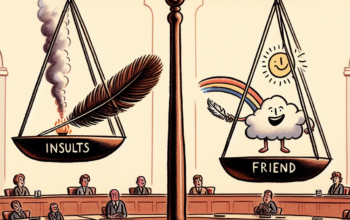The Rise of Independent Candidates in a Two-Party System
In an increasingly polarized political landscape, the rise of independent candidates has become a notable phenomenon within traditional two-party systems. Voters are increasingly disillusioned with established political parties and are seeking alternatives that resonate with their values and priorities. This shift towards independent candidates is not just a fleeting trend; it reflects deeper societal changes and a strong desire for political reform. As we delve into this important topic, it’s vital to understand how independent candidates are reshaping the political sphere and what implications they hold for the future of democratic governance.
The Historical Context of Independent Candidates
To grasp the current rise of independent candidates, one must first consider the historical context within which this trend is unfolding. Traditional two-party systems have often dominated the political landscape, especially in countries like the United States. The Democrats and Republicans have long vied for control, presenting voters with a binary choice that has largely defined electoral politics. However, the roots of independent candidacy can be traced back to various movements throughout history, where third-party candidates emerged to challenge the status quo and advocate for alternative viewpoints.
The 20th century saw sporadic successes for independent candidates, including figures like Ross Perot in the 1990s and Ralph Nader in the early 2000s. These individuals tapped into discontent with the two-party system, garnering significant support and influencing key political discussions. Fast forward to 2025, and we witness an accelerated trend where voters are increasingly opting for candidates outside of the traditional party lines. Current social movements and technological advancements, such as social media, play a critical role in amplifying the voices of independent candidates, allowing them to reach wider audiences and resonate with voter’s concerns.
Factors Driving the Growth of Independent Candidates
Several factors contribute to the rise of independent candidates in the contemporary political landscape. First and foremost is the widespread dissatisfaction with established parties. Many voters feel that the Democratic and Republican parties no longer represent their values or address their concerns adequately, especially on critical issues like climate change, healthcare, and wealth inequality. This growing disenchantment prompts voters to seek alternatives, leading to increased support for independent candidates who often position themselves as reformers.
Moreover, the evolution of technology and communication has democratized the political process, enabling independent candidates to campaign effectively without relying on the extensive resources that major parties possess. The rise of social media platforms allows these candidates to engage directly with voters, disseminate their messages quickly, and cultivate grassroots support. This evolution highlights a departure from traditional campaigning methods, particularly among younger voters who are increasingly drawn to independent candidates offering fresh perspectives and innovative solutions.
The Impact of Electorate Demographics and Trends
The demographics of the electorate play a crucial role in the rise of independent candidates. As the population becomes more diverse, so do the political opinions and priorities of voters. Millennials and Generation Z, for example, show a stronger affinity for independent candidates than their older counterparts. These younger voters, who tend to prioritize different issues such as climate justice, social equity, and civil rights, often feel unheard by established parties that are perceived as out of touch. As this demographic continues to grow in electoral influence, they actively seek out candidates who reflect their values, pushing independent candidates into the spotlight.
Additionally, regional variations contribute to the appeal of independent candidates. In areas where local governance and community needs are prioritized, independent candidates tend to fare better. As examples emerge, we can observe that many successful independent candidates advocate for issues that resonate specifically with their constituents. This localized approach often contrasts with the broader, often less relatable platforms of national parties. Recognizing this trend, independent candidates are increasingly tailoring their messages and campaign strategies to align with the unique interests of diverse voter bases, thus garnering wider support.
Case Studies: Successful Independent Candidates
To further understand the rise of independent candidates, we can look at specific case studies of individuals who have successfully navigated the two-party system. One notable example is Evan McMullin, an independent candidate who gained considerable traction during the 2016 presidential election. In 2025, McMullin remains active in political discussions and advocacy, reaping the benefits of a more independent-friendly political climate. His campaign showcased how an independent candidate could challenge traditional narratives and appeal to moderate voters who found themselves disenchanted with both major party options.
Another significant case is the recent success of independent gubernatorial candidates. In states like Maine and Alaska, independents have won high-profile races, demonstrating a palpable shift in voter sentiment. Maine’s Governor Janet Mills, initially an independent, highlighted the importance of bipartisanship and local governance. Her success underscored how independent candidates can connect authentically with their constituents, emphasizing the importance of community-centric policies over party loyalty.
These case studies reveal common strategies utilized by independent candidates, including grassroots mobilization, direct engagement with local communities, and a strong online presence. Their success stories illustrate how independent candidates can effectively challenge the conventional political establishment and resonate with voters seeking alternatives to traditional party politics.
The Challenges Facing Independent Candidates
Despite the notable rise of independent candidates, they face several challenges within the two-party system that can hinder their efforts. One significant hurdle is achieving ballot access, which often requires independent candidates to meet stringent requirements that vary from state to state. These legal barriers ensure that it remains easier for major party candidates to dominate electoral races. Overcoming these challenges requires meticulous planning, a deep understanding of local election laws, and substantial grassroots support.
Funding also represents a considerable obstacle for independent candidates. Established parties benefit from well-established fundraising networks and donor bases that provide essential financial resources for effective campaigning. Conversely, independent candidates often struggle to raise comparable funds, relying on small donations and grassroots contributions. This limited financial backing can hinder their ability to reach broader audiences and compete effectively against well-funded party candidates who have more resources at their disposal.
Finally, media coverage tends to favor major party candidates over their independent counterparts, often marginalizing their presence in political discussions. This media bias not only impacts public perception but also limits independent candidates’ exposure to potential voters. To combat this, many independent candidates have turned to alternative media platforms and grassroots mobilization strategies to amplify their messages and broaden their outreach, yet the challenge remains significant.
The Future of Independent Candidates in a Two-Party System
As we look to the future, the potential for independent candidates to reshape the political landscape within a two-party system appears promising yet fraught with challenges. Voter discontent with traditional parties continues to grow, and the demand for authenticity and reform is stronger than ever. With the political dynamics evolving swiftly, the next decade could witness a significant restructuring of how political campaigns are run, and independent candidates could play a pivotal role in that transformation.
Furthermore, as new social movements emerge around pressing issues like climate change and systemic inequalities, independent candidates will have opportunities to position themselves as relatable advocates for change. Their distinct perspectives and flexibility to adapt to local issues can attract voters who may feel overlooked by the mainstream parties’ platforms. If independent candidates can successfully leverage technology and grassroots strategies, the next elections could witness a more diverse and competitive political arena that reflects the complexity of voter sentiments.
In conclusion, the rise of independent candidates within a two-party system signifies a substantial shift in political dynamics, reflecting broader societal trends and voter dissatisfaction. The challenges they face are significant, yet their successful navigation of these obstacles could pave the way for more diverse representation in future elections. As political discontent continues to mount, the potential for independent candidates to influence the future of governance is not just a possibility; it is becoming a reality.
Conclusion
The rise of independent candidates in the two-party system highlights a strong demand for political reform and redefined representation. Historical contexts, voter demographics, and regional influences shape this movement, while successful candidates serve to inspire more independent voices. Nevertheless, challenges remain, including ballot access and funding, which must be addressed for these candidates to thrive fully. As we transition into the future, the engagement of independent candidates might serve as a vital catalyst for unlocking a more representative and responsive political sphere.
FAQs
1. Why are independent candidates gaining popularity?
Independent candidates are gaining popularity due to widespread dissatisfaction with established political parties, a desire for authentic representation, and pressing social issues that are not adequately addressed by the two-party system.
2. What are some key challenges independent candidates face?
Independent candidates face challenges such as stringent ballot access requirements, limited fundraising capabilities, and media bias that often favors major party candidates.
3. How can independent candidates be successful in elections?
To be successful, independent candidates need to focus on grassroots mobilization, engage with local communities, leverage social media for outreach, and tailor their messages to resonate with their constituents’ concerns.
4. Are independent candidates more successful in certain regions?
Yes, independent candidates often resonate better in areas where local governance and community needs are prioritized, as they can connect authentically with voters seeking alternatives to major parties.
5. What role does social media play in the rise of independent candidates?
Social media enables independent candidates to bypass traditional media gatekeepers, allowing them to engage directly with voters, disseminate their messages more efficiently, and build grassroots support.












